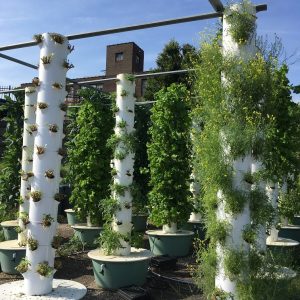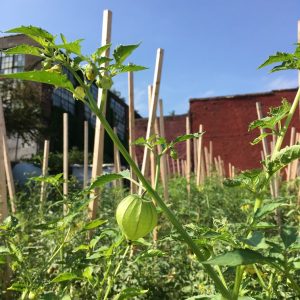Membership for the 100+ restaurants in the Green Dining Alliance has requirements for becoming part of our team. Members must not use styrofoam, they must provide single-stream recycling, and they must phase in energy efficient lighting. GDA members are also required to set goals to improve their environmental efforts in several different sections of sustainability: waste reduction, energy reduction, chemical use, education, innovation, and, of course, sourcing local food.
We are often asked why restaurants aren’t required to source local produce and animal products to be in the Green Dining Alliance – an excellent question that deserves an in-depth response. We love it when restaurants source locally – restaurants who do this tend to get 4 stars and up for “sourcing” in their ratings. Several of our restaurants are so committed to local foods that they have their own urban farms – check out our blog series on these farmer restaurants here.

Vertical towers abound at Vin de Set’s Urban Farm
The GDA cares about local food for several reasons. Local food supports our local economy, as a greater percentage of the money spent on food goes to the grower instead of middle-men like packagers, shipping companies, and processing facilities. Food grown in the region also strengthens our food system – relying on foods that are shipped from halfway around the world could be a serious problem in the event of a crisis such as a gas shortage, natural disaster, or other catastrophe that would make transportation difficult. Local food is also more nutritious than produce that has to travel far – the 1,000+ mile journey would wear anyone out, including fruits and veggies, which lose nutrition (and flavor) during their epic journey. Additionally, growing food locally can help reduce food insecure areas – AKA food deserts – by turning unused land into food production areas.
Local foods, like those found at the Tower Grove Farmers Market, Ferguson Farmer’s Market, or the Schlafly Farmer’s Market, are likely to be grown with organic principles – these not only protect consumers from residual pesticides and other chemicals, but also can be more nutritious! According to this NPR article, when some vegetables are left to their own devices to ward off pests they release compounds that are unpleasant-tasting to insects, but valuable to human health when consumed. Science is so cool, right??
Back to the original question, if local food is so important for food security, nutrition, and the local economy, why isn’t it required for restaurants in the GDA to source all local ingredients? The answer, unfortunately, lies in feasibility. Local foods can be more expensive than commodity crops that have traveled the globe to make it to your plate – this is due in part to subsidies that the fossil fuel industry and big agriculture enjoy. These subsidies make it difficult for local farmers to compete with bigger farming corporations or to earn a good living. According to a food study report written by the Missouri Coalition for the Environment, MO agriculture workers earn less than the average worker, which means that small farmers have to “not only do Missouri agricultural workers on average make 8% less than the average Missouri worker.” Those who actually grow the food, according to the study, make “less than half” of those who package, ship, and process the food.
According to Andy Ayers, formally of Eat Here St. Louis, who was interviewed for the MCE food study, “the higher per-unit cost of raising a tomato on a small farm in our [Foodshed] puts local tomatoes at a cost disadvantage compared to the economies of hundreds-acre tomatoplantations in Florida, Mexico, Texas,
etc. This is directly related to artificially low petroleum prices from the fertilizers and pesticides used by the mono-crop farms to the diesel fuel the 18-wheelers use to bring produce into this market.” In other words, the cost of a local tomato, unfortunately, can cost more than a competing tomato that comes from Mexico.
This cost difference makes it more difficult for restaurants, an industry whose profit margin hovers around 7%, to price their food if they’re buying locally. The costs of purchasing more expensive produce and animal products would need to be passed down to the consumer, and many restaurants are concerned that the higher cost will scare off their regulars. Additionally, there is not enough local, responsibly raised foods in the region for our restaurants to source a farm-fresh menu, even during the height of the growing season. This might be confusing, as most of us know that those of us in the Midwest live in the “breadbasket” of America, but much of our agricultural land has been devoted to monocultures like corn and soy – very little of which is used to feed humans. Instead, these crops are grown for animals in CAFOs (Concentrated Animal Feedlot Organizations), or used as ethanol.
The GDA always recommends to restaurants who aren’t already including locally sourced items on their menu to give it a try with at least one item, either as a special or as a “farm fresh” regular item,at an upcharge – and to let diners know why the item costs more. That way, they can test their customers, to see if eating locally is something they value. If more restaurants start purchasing more local food, even small amounts, demand will increase, encouraging more farmers to grow food in our region.

Local tomatillo at Vin de Set’s urban farm
Eating locally, whenever possible, is important to the GDA, but we understand that practical needs have to be considered both when we do our grocery shopping and when we dine out – but we always jump at the chance to try food raised in a garden, urban farm, or regional farm.
If eating local food is important to you, let your favorite restaurant know – ask if anything is local on the menu, and put your money where your mouth is by purchasing local produce and pasture-raised animal products whenever you can!




